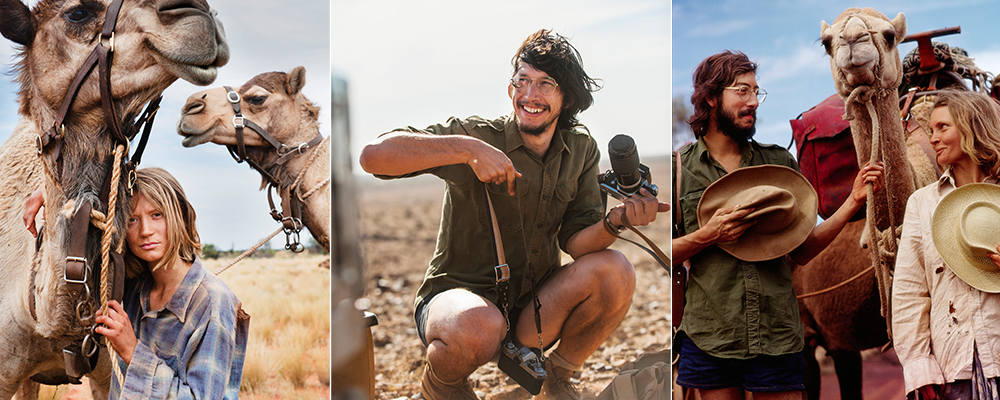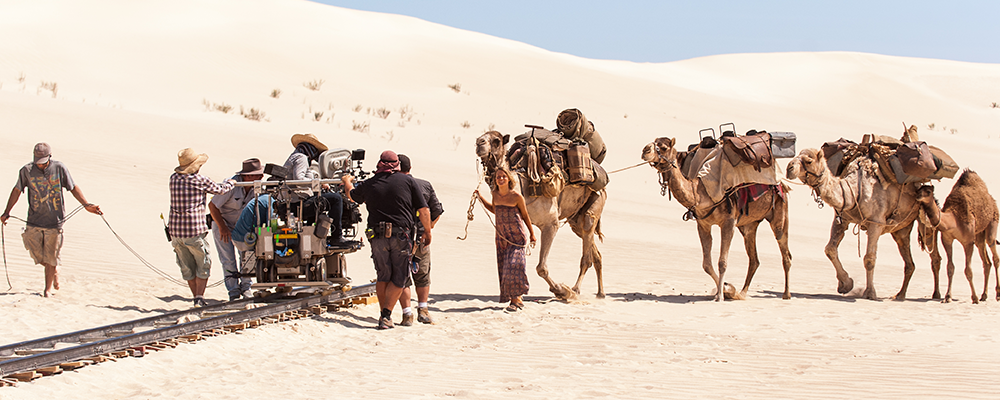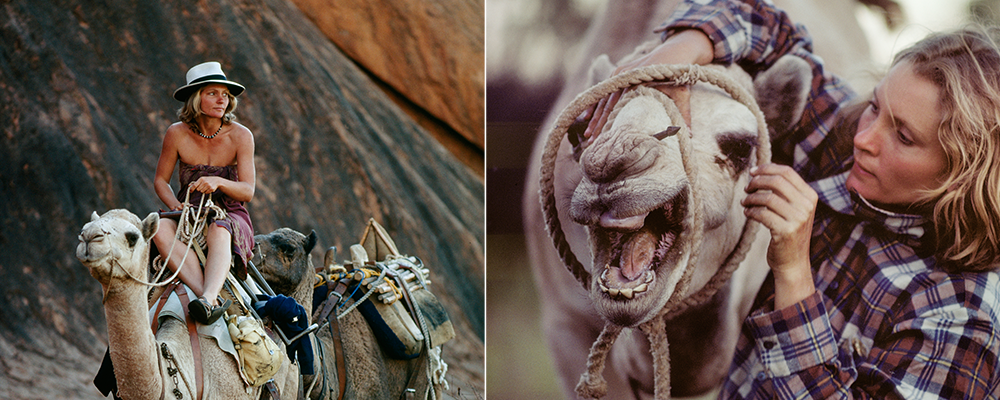‘Tracks’ Director John Curran and Photographer Rick Smolan Discuss Bringing Robyn Davidson’s Journey to the Big Screen
Emily Manthei
A good film is a journey: a story that takes the viewer from beginning to end on a movement through space, time, and emotion. Tracks is also a “journey” film in the literal sense. It’s the true story of an Australian woman’s solitary walk across nearly 1,700 miles of Australian desert from Alice Springs to the Indian Ocean and the photos of an intrepid National Geographic photographer who dropped in on her along the way. But, more importantly, it’s a journey film in the philosophical sense, as it invites viewers to take their own journey: from curiosity to discovery; self-doubt to confidence; adolescence to adulthood. It’s the journey so many of have experienced in the open-handed, non-destination-based travels of youth.
John Curran’s new film starring Mia Wasikowska is this mesmerizing, filmic journey, adapted from the real-life traveler Robyn Davidson’s 1980 memoir of the same name. It was written after the overwhelming response to her National Geographic article and the photos by Rick Smolan, which accompanied it in 1977. Adam Driver co-stars as Smolan.
The story of the film began in 1984, when director John Curran was 24 years old, a native New Yorker on his way to Australia to escape the hectic, ambitious world he knew. He was handed some reading material for his journey: “A Day in the Life of Australia,” a giant coffee table book filled with lush, gorgeous photos of places he had never been, photographed by a man whose name he did not then know: Rick Smolan.
“I wanted to explore, to travel—without really knowing why,” Curran remembers.
This 20-something wanderlust—a combination of soul-searching, curiosity and maybe even a bid to escape adulthood—made Curran a kindred spirit with those he encountered in the early days of what turned out to be a fertile 18 years of living and working in Australia, which included the launch of his film career. It was on his backpacking travels in the first months after arriving in Australia that he encountered the book “Tracks,” by Robyn Davidson.
“By then, Robyn was an iconic figure to young travelers—especially young women—in Australia,” Curran remembers.
The book spoke in poetic detail about some of the most remote, unexplored places in the country, with a compassionate rendering of the native Aboriginals who were the barren landscape’s only inhabitants. But it wasn’t until almost 25 years later, when Curran was offered the film, that he first read the book. “I felt I had a lot of distance from my 24-year-old self, but it all came back to me when I read the book. I really related to it; I remembered that age and understood it.”
It is this thoughtful, poetic journey, which Curran first discovered through Smolan’s photographs, later through his own adventures, and finally by reading Davidson’s book, that form the foundation of the film. “It was a pivotal time in my life,” Curran says. “When you’ve traveled, and you’re open to it, you notice the smells and the colors. All the details you don’t notice when you’re home. There were so many impressions washing over me the first five years [that I lived in Australia] before everything became familiar. The film was an opportunity; I was able to bring some of that into the film. Some of the impressions of the period.”
Although refusing all potential human travel companions, Robyn makes her crossing accompanied by four accommodating camels and her black lab. Looking at the animals with whom she shares her journey reiterate her own methodology: She is silent but thoughtful; a force of unbroken will with a touch so soft it almost melts; a pragmatic survivalist, but not without empathy.
“Many people who love animals—especially women—are portrayed as having some deficiency in relating to people,” her voice-over in the film tells us. “I suspect most of those critics have never had an animal.” And indeed her feeling of being misunderstood and her need to assert an utter lack of concern for those who misunderstand her seem to motivate her journey, at least in some part.
The sparse, dream-like narrative that winds its way through Robyn’s preparation on a small farm in Alice Springs, and almost 200 days in the Australian desert, is shot so beautifully it nearly erases the harshness of the barren and difficult conditions. But the effect is contemplative, as the viewer is swept into Robyn’s thoughts and feelings, interspersed with tasteful flashbacks in the guise of desert mirages.
“I knew the story itself was a challenge,” Curran relates. “I would have to push myself beyond what I understood. The script would never be right. The story is so solitary and the plot itself is in a way…thin. This would be a film made in the edit room. It would become what it would be.”
And indeed, the experiential quality of the film brings to bare that assessment. The sequences of the film vacillate between gain and loss, where every step of Robyn’s journey means moving on to something new while leaving an old discovery or moment behind.
“I will not justify my need for solitude,” her voiceover tells us. Even the endlessly chatty Smolen, whose magazine, National Geographic, she enlisted to pay for her travels, sometimes proves too much of a presence for the introspective Robyn to handle on his one-day visits throughout her journey, in which he poses her for pictures atop camels, sneaks into “secret meetings” at Aboriginal camps and talks endlessly about his jet-setting lifestyle as a traveling photographer. She can turn on a dime from infuriated frustration to passion.
The real-life Smolan remembers things a little differently than the film portrays him. “I understand that a character has to have an arc and everything, but that wasn’t really the way it was between us,” he says. “My loyalty was always to her and not to National Geographic. In fact, I edited the photos myself, which I wasn’t supposed to do, because there were some personal photos of her that I knew she wouldn’t want in the magazine. I was shooting myself in the foot from day one by breaking all the cardinal rules. Although I think the film is wonderful, I’m not a paparazzi. I don’t set pictures up and get people to pose.” Smolan stops for a breath and a chuckle. “Look at me – talking your ear off.”
But Smolan can’t suppress the obvious passion he has for talking about Robyn. His narrative of Robyn’s journey takes its own shape, as it is the journey of a young man falling in love.
“The year I followed her was, for me, the year of growing up. Like when you’re 19, and you grow up finally, into a man.”
Smolan was 28 at the time, drifting from one exotic locale to another taking photos for Life and Time magazines. While taking photos of Aboriginals in Alice Springs for a piece in Time, he found himself taking a photo of the beautiful young woman washing the windows at his hotel. Incensed at his intrusion, Davidson confronted him.
“She thought I was a parasite,” he recalls, both for taking her photo and for photographing the Aboriginals. “I apologized,” he added. Smolan then told her how his photographs of the Aboriginals were going to help expose their treatment at the hands of the Australian government to the world. This was the first meeting of the two and it would lead to many more heated discussions, in which Davidson would always speak her mind, leading Smolan to greater insights and self-reflection.
“She was 27,” he remembers, “but she was so much older than me. So much wiser. She was so focused and fierce.”
Davidson was, at the time, preparing for her trip across the desert with her camels, but she had so far failed at finding a sponsor. Even after their somewhat caustic confrontations, she asked Smolan—through a friend—if she could use his name in a letter to National Geographic, which would ask for the money to finance her trip. Because he was a photographer (albeit without any photos in Geographic), she thought, the magazine might respond if he were to be on board as the photographer. And they did, by calling Smolan and asking his opinion of Robyn’s trip and whether or not to fund it. Smolan, of course, enthusiastically persuaded them and was subsequently assigned his first story with the iconic magazine. (In the film version, Smolan is assigned as the photographer for Robyn’s trip after she secures the money from National Geographic through her own efforts.)
This began the friendship that blossomed into romance between them. Every five or six weeks, Smolan—through the help of the Aboriginals—would find Robyn and spend a day photographing her somewhere on her journey.
“It never took more than 24 hours to find her,” Smolan recalls. “The Aboriginals always knew exactly where she was, whereas the maps she had given me just gave me a vague idea.”
In the film, Robyn resents her photographic “keeper” and his intrusions at first, but as he grows to understand her more, their relationship blossoms. “So many people spend time avoiding things they’re afraid of; Robyn goes towards the things that frighten her. I was inspired by her attitude: ‘I’m scared and I do it anyway.’”
Perhaps Smolan’s assessment is the closest thing we have to understanding the motivations for Robyn’s trip.
This courageous stance, seen from a woman’s perspective, was also what drew Curran to Robyn’s story. “The people that have had the most profound impact on my life were women. To me, because I’m a man, men aren’t mysterious. Women are endlessly fascinating, endlessly mysterious. And that’s what the job [as a director] is: trying to get to things you don’t understand. Strong female protagonists interest me more than doing a heroic guy story.”
Curran set out to capture the essence of that solitary, feminine strength he saw, without ruining the contemplative desert experience with the vast, loud, electronic village that is a film set. “I cast a lot of women in the crew. The director of photography, production designer, costumes, makeup—they were all women. That was purposeful. There is a different energy when a lot of women work together. I felt for me it would be a different experience with a lot of women around on set.”
Long lenses and open spaces also helped maintain the experience of the contemplative mystic on an internal journey in the vast, dream-like sequences of the film. And then, of course, there was Robyn herself: Mia Wasikowska.
Curran said he felt the pressure of casting, as an American director doing a quintessentially Australian story, right away.
“She [the person to play Robyn] definitely existed—it was Mia. I wasn’t going to cast an American woman,” Curran said. “But I didn’t have to go very far, either. You look at Robyn, and it’s Mia.”
And Wasikowska came to the project quickly, understanding right away that Curran was the kin of other singular, visually meditative directors she loves to work with (Jim Jarmusch, Gus Van Sant and Chan-wook Park among others).
As for Adam Driver, who was then just getting his start with “Girls,”Curran said he was similarly confident.
“I was reading some critic’s description of Adam as the ‘weirdest’ or ‘strangest’ or some superlative about his character [in “Girls”]. I looked him up online. He had that kind of tall, gangly look. He had so many qualities that I thought were Rick-like.”
Both the physical and psychological similarities between the real-life characters and the actors are immediately visible when viewing Smolan’s beautiful photos of the real Robyn’s journey at the end of the film. The thread that runs between Robyn and Wasikowska is immediately visible and immensely captivating, even as still photographs. Smolan and Driver, too, create a doppelganger effect, without the impression that Driver or Wasikowska are “imitating” their real-life inspirations. Each actor gives the authentic sense of truly undertaking the journey of the film: a slow-burn voyage where heart and mind engage, the reward of which is simply coming out the other side. As (filmic) Robyn reminds us, “A journey is not about what you carry, but about what you leave behind.”
Back in real life, Robyn continued to inspire Smolan, even after they met for their final series of photos at the Indian Ocean. And through the years they remained friends, even without seeing each other for years at a time as Smolan continued to photograph unseen parts of the world. “At the end of her trip, Robyn asked if I was going back to being a prostitute [as a shoot-for-hire photographer]. She told me, ‘You need to find a way to use your photography to change things, not just document them.’”
Smolan responded with a six-month, self-funded trip photographing often-ostracized Asian kids fathered by American G.I.’s. This resolved itself to action when Smolan found an adoptive family for one such child from South Korea.
Tracks opens in theaters September 19.




